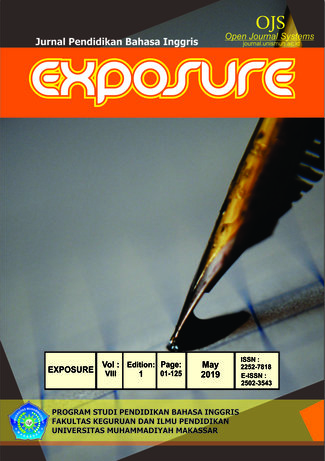ANALYSIS OF SOCIAL PROBLEM IN A GOOD MAN IS HARD TO FIND BY FLANNERY O’CONNOR
DOI:
https://doi.org/10.26618/exposure.v8i1.1717Keywords:
A Good Man Is Hard to Find, Flannery O’Connor, social problem, crime, social status, disorganization familyAbstract
This study aims to describe the problems of social problems contained in the short story "A Good Man Is Hard to Find" by Flannery O'Connor. This research is descriptive qualitative. The data source obtained in the short story is "A Good Man Is Hard to Find" by Flannery O'Connor. The results of this study are: (1) Family disorganization, due to lack of communication and lack of social relations within the Bailey family, (2) Crime, the Misfit who came out of the prisoner all members of the Bailey family, (3) Social status, the grandmother who is selfish and does everything she can to maintain social status and people's views on her. On the basis of the results, it has been concluded and by using the sociological aspect that the social problem events in the story can be a lesson and improve understanding and interpretation in communicating and socializing in life. This study is hopefully more useful for readers of literary books, especially the work of Flannery O'Connor and writers.References
Thuan, Le Thi Bich. “Character Analysis Through Politness in A Good Man Is Hard to Find by Flannery O’Connor.” International Journal of Applied Linguistics & English Literature, vol. 6, no. 4, 2017, pp. 218-226.
B Berk, Bernard. “Labeling Theory, History of”, Elsevier Ltd, 2005.
Lengyel, Peter. “Sociology of Literary Creativity.” Social Science Journal, vol.19, no. 4, 1967, pp. 494-664.
Abdulla Shafiq, Jinan. “A Study in Flannery O’Connor’s ‘A Good Man is Hard to Find’ and ‘Good Country People’.” Journal of the Faculty of Basic Education, vol. 23, no. 97, 2017, pp. 11-20.
Sreekumar. “Family Disorganization and Children.” International Journal of Education and Applied Sciences Research, vol. 4, no. 1, 2017, pp. 19-23.
Sergio, Antonio. “Sociology Beyond Social Class.” Journal of Brazilian Sociological Society, vol. 2, no. 1, 2016, pp. 60-76.
Cristina, Maria. “Violence In “A Good Man is Hard to Find”: The Faces of Marginality.” Dialogical Interchanges Language and Literature in Contemporary Society, vol. 7, no. 1, 2007, pp. 133-144.
Gunindi, Yunus. “Function of the Family: Family Structure and Place of Residence.” Energy Education Science and Technology Part B: Social and Educational Studies, vol. 4, no. 1, pp. 549-556.
Aras, Goksen. “Personality and Individual Differences: Literature in Psychology-Psychology in Literature.” Procedia-Social and Behavioral Sciences, vol.1, no. 185, 2015, pp. 250-257.
Serravalle. A Good Man is Hard to Find: Flannery O’Connor. Gothic Digital Series, 1953.
Tsai, Hsui-chih. “Viloence as the road to Transformation: O’Connor’s “A Good Man is Hard to Find”.” NTU Studies in Language and Literature, no. 13, 2004, pp. 59-98.
O’Connor, Flannery. A Good Man Is Hard to Find. Course Hero, 2017.
Nadal, Marita. “Temporality and Narrative Structure in Flannery O’Connor’s Tales.” Journal of the Spanish Association of Anglo-American Studies, vol. 31, no. 1, 2009, pp. 23-39.
Yunfei, Deng. “Flannery O’Connor’s Original Sin and Redemption A close reading of A Good Man is Hard to Find.” International Journal of Liberal Arts and Social Science, vol. 4, no. 1, 2016, pp. 107-111.
Hooten, Jessica. "Individualism in O'Connor's A Good Man is Hard to Find." Literature Resource Center, vol. 66, no. 4, 2012.
Downloads
Published
Issue
Section
License
Authors who publish with this journal agree to the following terms:
In order to assure the highest standards for published articles, a peer review policy is applied. In pursue of the compliance with academic standards, all parties involved in the publishing process (the authors, the editors and the editorial board and the reviewers) agree to meet the responsibilities stated below in accordance to the Journal publication ethics and malpractice statement.
Duties of Authors:
- The author(s) warrant that the submitted article is an original work, which has not been previously published, and that they have obtained an agreement from any co-author(s) prior to the manuscript’s submission;
- The author(s) should not submit articles describing essentially the same research to more than one journal;
- The authors(s) make certain that the manuscript meets the terms of the Manuscript Submission Guideline regarding appropriate academic citation and that no copyright infringement occurs;
- The authors(s) should inform the editors about any conflict of interests and report any errors they subsequently, discover in their manuscript.
Duties of Editors and the Editorial Board:
- The editors, together with the editorial board, are responsible for deciding upon the publication or rejection of the submitted manuscripts based only on their originality, significance, and relevance to the domains of the journal;
- The editors evaluate the manuscripts compliance with academic criteria, the domains of the journal and the guidelines;
- The editors must at all times respect the confidentiality of any information pertaining to the submitted manuscripts;
- The editors assign the review of each manuscript to two reviewers chosen according to their domains of expertise. The editors must take into account any conflict of interest reported by the authors and the reviewers.
- The editors must ensure that the comments and recommendations of the reviewers are sent to the author(s) in due time and that the manuscripts are returned to the editors, who take the final decision to publish them or not.
Authors are permitted and encouraged to post online a pre-publication manuscript (but not the Publisher’s final formatted PDF version of the Work) in institutional repositories or on their Websites prior to and during the submission process, as it can lead to productive exchanges, as well as earlier and greater citation of published work (see The Effect of Open Access). Any such posting made before acceptance and publication of the Work shall be updated upon publication to include a reference to the Publisher-assigned DOI (Digital Object Identifier) and a link to the online abstract for the final published Work in the Journal.

